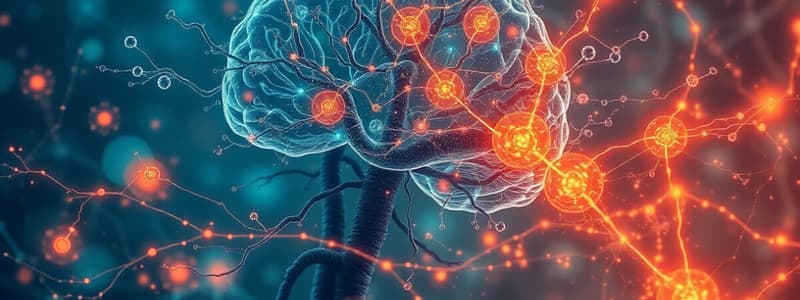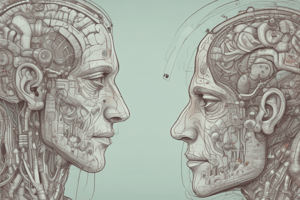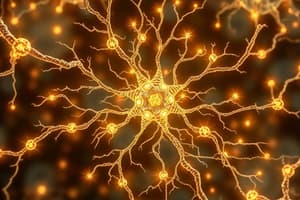Podcast
Questions and Answers
What are the three ancient civilizations mentioned in the text as having contributed to the study of the nervous system?
What are the three ancient civilizations mentioned in the text as having contributed to the study of the nervous system?
The three ancient civilizations mentioned are Egypt, Greece, and Rome.
What is the primary focus of Chapter 1 in this course?
What is the primary focus of Chapter 1 in this course?
Chapter 1 focuses on the historical development of neuroscience, exploring how concepts of nervous system function have evolved across different civilizations and eras.
What is the time period covered in the historical overview of neuroscience presented in Chapter 1?
What is the time period covered in the historical overview of neuroscience presented in Chapter 1?
Chapter 1 covers the period from ancient Egypt, Greece, and Rome to the 19th century.
What is the primary goal of the lecture outlined in Chapter 1?
What is the primary goal of the lecture outlined in Chapter 1?
What are the two dates of the midterm exams in this course?
What are the two dates of the midterm exams in this course?
What was Vesalius's major contribution to the understanding of the human body during the Renaissance?
What was Vesalius's major contribution to the understanding of the human body during the Renaissance?
According to the fluid-mechanical theory of brain function, how did animal spirits operate?
According to the fluid-mechanical theory of brain function, how did animal spirits operate?
Describe the philosophical dilemma posed by the mind-brain problem during the Renaissance?
Describe the philosophical dilemma posed by the mind-brain problem during the Renaissance?
What significant scientific observation did René Descartes make regarding the function of the pineal gland?
What significant scientific observation did René Descartes make regarding the function of the pineal gland?
Identify the key difference between the Renaissance view of nerves and the earlier spirit-animals theories.
Identify the key difference between the Renaissance view of nerves and the earlier spirit-animals theories.
Explain the significance of the distinction between white and gray matter in the nervous system.
Explain the significance of the distinction between white and gray matter in the nervous system.
What key features of the brain's anatomy were described during the period from the Renaissance to the 19th century?
What key features of the brain's anatomy were described during the period from the Renaissance to the 19th century?
Compare the understanding of the brain's structure in Galen's time with the view that emerged in the 19th century?
Compare the understanding of the brain's structure in Galen's time with the view that emerged in the 19th century?
What was the primary contribution of Camillo Golgi to the understanding of the nervous system?
What was the primary contribution of Camillo Golgi to the understanding of the nervous system?
How did Ramon y Cajal's views differ from those of Golgi regarding the organization of the nervous system?
How did Ramon y Cajal's views differ from those of Golgi regarding the organization of the nervous system?
What is the cellular theory of the nervous system?
What is the cellular theory of the nervous system?
What are specialized visual areas in monkeys thought to contribute to?
What are specialized visual areas in monkeys thought to contribute to?
Explain the debate referred to as the 'Soup versus Spark' controversy.
Explain the debate referred to as the 'Soup versus Spark' controversy.
What evidence from prehistoric ancestors supports the notion that the brain was vital for life?
What evidence from prehistoric ancestors supports the notion that the brain was vital for life?
Why was the brain removed during the mummification process in Ancient Egypt?
Why was the brain removed during the mummification process in Ancient Egypt?
According to Hippocrates, what was the root cause of disease?
According to Hippocrates, what was the root cause of disease?
What was the role of the heart in Hippocrates' theory of the humors?
What was the role of the heart in Hippocrates' theory of the humors?
What was Galen's contribution to neuroscience, considering he was forbidden to dissect human cadavers?
What was Galen's contribution to neuroscience, considering he was forbidden to dissect human cadavers?
Why did Galen believe the ventricles were important for brain function?
Why did Galen believe the ventricles were important for brain function?
What part of the brain did Galen associate with sensations?
What part of the brain did Galen associate with sensations?
What part of the brain did Galen associate with controlling muscles?
What part of the brain did Galen associate with controlling muscles?
Describe the experimental method Pierre Flourens used to investigate brain function and explain the limitations of this method.
Describe the experimental method Pierre Flourens used to investigate brain function and explain the limitations of this method.
What was the central idea behind phrenology, and what were its main strengths and weaknesses?
What was the central idea behind phrenology, and what were its main strengths and weaknesses?
Describe Broca's key contribution to the understanding of brain function. What was his observation, and what did it suggest?
Describe Broca's key contribution to the understanding of brain function. What was his observation, and what did it suggest?
Explain the findings of Fritsch and Hitzig, and Ferrier concerning the motor cortex.
Explain the findings of Fritsch and Hitzig, and Ferrier concerning the motor cortex.
What was the significance of Phineas Gage's accident for our understanding of the brain's role in personality and higher cognitive functions?
What was the significance of Phineas Gage's accident for our understanding of the brain's role in personality and higher cognitive functions?
How does Darwin's theory of natural selection inform our understanding of the evolution of the nervous system?
How does Darwin's theory of natural selection inform our understanding of the evolution of the nervous system?
Describe the rationale for using animal models in neuroscience research.
Describe the rationale for using animal models in neuroscience research.
Explain how Darwin's theory of evolution can be applied to understanding the specialization of brain regions.
Explain how Darwin's theory of evolution can be applied to understanding the specialization of brain regions.
What was the main dispute in the 'soup versus spark' controversy?
What was the main dispute in the 'soup versus spark' controversy?
List the five levels of analysis in the reductionist approach to neuroscience.
List the five levels of analysis in the reductionist approach to neuroscience.
What role does a neurologist play in the field of neuroscience?
What role does a neurologist play in the field of neuroscience?
How do developmental neurobiologists contribute to neuroscience?
How do developmental neurobiologists contribute to neuroscience?
What is the primary focus of a neuropharmacologist?
What is the primary focus of a neuropharmacologist?
Identify one field of neuroscience that uses computational methods.
Identify one field of neuroscience that uses computational methods.
What is the focus of neural pathology and repair researchers?
What is the focus of neural pathology and repair researchers?
What do neuroethologists study?
What do neuroethologists study?
Flashcards
Mid-term Exam 1
Mid-term Exam 1
First assessment covering lectures 1-7, worth 25% of final grade.
Cumulative Final Exam
Cumulative Final Exam
Final assessment covering all material, 50% of final grade.
Make-up Exam Policy
Make-up Exam Policy
Missed mid-terms transfer weight to final; no need to justify absence.
Adjustment of Exam Weights
Adjustment of Exam Weights
Signup and view all the flashcards
Origin of Neurosciences
Origin of Neurosciences
Signup and view all the flashcards
Trepanation
Trepanation
Signup and view all the flashcards
Views of Ancient Egypt
Views of Ancient Egypt
Signup and view all the flashcards
Hippocrates' Contributions
Hippocrates' Contributions
Signup and view all the flashcards
Bodily Humours Theory
Bodily Humours Theory
Signup and view all the flashcards
Galen's Animal Experimentation
Galen's Animal Experimentation
Signup and view all the flashcards
Ventricles' Role
Ventricles' Role
Signup and view all the flashcards
Prehistoric Views on the Brain
Prehistoric Views on the Brain
Signup and view all the flashcards
Galen's Exploration of Brain
Galen's Exploration of Brain
Signup and view all the flashcards
Pierre Flourens
Pierre Flourens
Signup and view all the flashcards
Ablation method
Ablation method
Signup and view all the flashcards
Broca's area
Broca's area
Signup and view all the flashcards
Phrenology
Phrenology
Signup and view all the flashcards
Electrical stimulation (Motor areas)
Electrical stimulation (Motor areas)
Signup and view all the flashcards
Phineas Gage
Phineas Gage
Signup and view all the flashcards
Darwin's natural selection
Darwin's natural selection
Signup and view all the flashcards
Animal models
Animal models
Signup and view all the flashcards
Neuron
Neuron
Signup and view all the flashcards
Cellular theory
Cellular theory
Signup and view all the flashcards
Reticular network hypothesis
Reticular network hypothesis
Signup and view all the flashcards
Camillo Golgi
Camillo Golgi
Signup and view all the flashcards
Ramon y Cajal
Ramon y Cajal
Signup and view all the flashcards
Synaptic Stimulation
Synaptic Stimulation
Signup and view all the flashcards
Post-Synaptic Potentials
Post-Synaptic Potentials
Signup and view all the flashcards
Ligand-Gated Channels
Ligand-Gated Channels
Signup and view all the flashcards
Reductionist Approach
Reductionist Approach
Signup and view all the flashcards
Neurologist
Neurologist
Signup and view all the flashcards
Neuroscientist
Neuroscientist
Signup and view all the flashcards
Neuropharmacologist
Neuropharmacologist
Signup and view all the flashcards
Neural Pathology
Neural Pathology
Signup and view all the flashcards
Vesalius
Vesalius
Signup and view all the flashcards
Cogito ergo sum
Cogito ergo sum
Signup and view all the flashcards
Gray matter vs White matter
Gray matter vs White matter
Signup and view all the flashcards
Central Nervous System (CNS)
Central Nervous System (CNS)
Signup and view all the flashcards
Peripheral Nervous System (PNS)
Peripheral Nervous System (PNS)
Signup and view all the flashcards
Electric Transmission in Nerves
Electric Transmission in Nerves
Signup and view all the flashcards
Localization of Function
Localization of Function
Signup and view all the flashcards
Pineal Gland
Pineal Gland
Signup and view all the flashcards
Study Notes
Course Information
- Course Title: Principles of Neurobiology
- Course Code: BIO/CMM-3350
- Instructor: Tuan Bui
- Email: [email protected]
- Phone: 613-562-5800 ext. 7888
- Location: GNN 285
Lectures
- Schedule: Tuesdays (8:30 AM - 10:00 AM) and Fridays (10:00 AM - 11:30 AM)
- Livestreaming and recordings will be provided on Brightspace
- Technical issues may prevent livestreaming or recordings
Examinations
- Mid-term 1: Tuesday, February 4th, 25% (Lectures 1-7)
- Mid-term 2: Friday, March 14th, 25% (Lectures 9-15)
- Final Exam: 50%, cumulative, with emphasis on lectures 8, 16-22 (66-75%)
Make-up Exam Policy
- No deferred exams allowed
- Absence from a midterm exam does not require justification.
- The weight of missed midterms will be transferred to the final exam.
- A Declaration of Absence for an Examination is not required when missing a midterm.
- For students writing both midterms and the final exam, the weight of the best exam (midterm or final) will be increased by 15% and the weight of the lowest midterm exam will be decreased by 15%.
Chapter 1: Neurosciences, Past, Present, Future
- Topics covered in this lecture: Evolution of concepts of the nervous system function and operation in different eras and civilizations
- Readings: Bear, chapter 1
Origins of Neurosciences
- Prehistoric ancestors, Ancient Egypt, views of Ancient Greeks (Hippocrates), views of Ancient Rome (Galen)
Prehistoric Ancestors
- Brain is vital for life
- Cranial surgeries (Trepanation)
- Evidence of healing suggesting the awareness of the brain's importance in life and health
Views of Ancient Egypt
- Heart: believed to be the seat of the soul, conscience, and emotions, and memory
- Brain disposal during mummification due to poor preservation properties of brain lipids in natron
Views of Ancient Greece (Hippocrates)
- Correlation between brain structure and its function.
- Rejected superstitions/ beliefs as causes of diseases
- Theories of bodily humours (fluids) and their effect on health.
- Imbalance of four humours (blood, phlegm, yellow bile, black bile)
- Blood: warm, cheerful personality
- Phlegm: calm, sluggish personality
- Yellow bile: quick-tempered, irritable personality.
- Black bile: melancholic, gloomy personality
- Brain, pituitary, and their correlation with personality
Views of the Roman Empire (Galen)
- Human cadaver dissections were forbidden
- Galen studied gladiators
- Performed animal experimentation
- Explored brain, cerebellum, and ventricles roles
- Ventricles: contained four humors and functioned as the center of sensory information, initiating muscle responses, and the conduits for humors throughout the brain.
Views of the Renaissance
- Vesalius performed human body dissections (1514-1564)
- Fluid-mechanical theory of brain function: animal spirits moving through the ventricles.
- Philosophical mind-brain problem: divine mind vs. material brain.
- Resolution by René Descartes (1596-1650), proposing that the pineal gland is the seat of the soul (“Cogito ergo sum”).
Views of the 17th and 18th Centuries
- Nerves are not tubes that contain the spirits. White matter is continuous with nerves and contains fibers that connect the brain's gray matter to transmit information.
- Distinction between gray and white matter.
Views of the 19th Century: The Cell Theory
- Anatomical description of gyri, sulci, and fissures.
- Bipartite brain (Galen) to the 19th-century understanding of five brain parts.
- Central and peripheral nervous system (CNS, PNS) divisions in the brain and spinal cord.
- Nervous systems are electrical cables that transmit electricity (Luigi Galvani).
- The nervous system generates electricity (similar to Leyden jar, electric fish)
Views of the 19th Century: Localization of Function
- Methods: Experimental ablation (Pierre Flourens), electrical stimulation, and neurological case studies
- Flourens’s work on the cerebellum and motor coordination: too broad
- Phrenology (Franz Gall): Bumps on the skull reflect brain function, correlated with personality traits
- Broca’s area discovery: Speech production center
- Other methods lead to the identification of motor areas (electrical stimulation in dogs, monkeys), and of visual areas (and their correlation with vision loss, animal models).
- Phineas Gage’s accident - Destruction of the frontal ventro-medial area and its correlation with personality changes
Evolution of the Nervous System
- Natural selection by Darwin (1809-1882)
- Shared ancestral origins of diverse species
- Nervous systems: common mechanisms
- Rationale for animal studies (squid for action potential transmission, rats for addiction studies)
- Darwin’s theory: regions of the brain adapted according to species' environments (visual and whisker areas)
Neuron: Basic Unit
- Cellular theory of the nervous system
- Neuron as a basic unit, not a reticular network (reticular hypothesis)
- Golgi's (1843-1926) staining technique and its impact on the study of neurons
The "Soup vs. Spark" Controversy
- Eccles: synaptic stimulation is electrical
- Katz and colleagues: synaptic stimulation is chemical
- Resolution by discovery of post-synaptic ligand-gated channels
- Explanation of synaptic transmission and quanta
Neuroscience Today
- Reductionist approach to understanding the Nervous System-
- Levels of analysis (molecular, cellular, systems, behavioral, cognitive)
- Diverse Medical Specialists (Neurologists, Psychiatrists, Neurosurgeons, Neuropathologists)
Researchers in Basic Neuroscience
- Various types and their specific fields of study
Studying That Suits You
Use AI to generate personalized quizzes and flashcards to suit your learning preferences.




